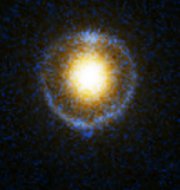The Canarias Einstein ring discovered by Scientists
Friday 3rd of June 2016

Sharing is caring
An international team of astrophysicists have discovered an unusual astronomical object — an Einstein ring.
This phenomenon was predicted by Einstein’s theory of General Relativity and has been given its own name “The Canarias Einstein ring”.
Einstein’s General Relativity was published in 1915, but a few years before that, in 1912, Einstein predicted the bending of light. Russian physicist Orest Chwolson was the first to mention the ring effect in scientific literature in 1924, which is why the rings are also called Einstein-Chwolson rings.
Gravitational lensing is fairly well-known, and many gravitational lenses have been observed. Einstein rings are rarer, because the observer, source, and lens all have to be aligned. Einstein himself thought that one would never be observed at all. “Of course, there is no hope of observing this phenomenon directly,” Einstein wrote in 1936.
The team behind the recent discovery was led by PhD student Margherita Bettinelli at the University of La Laguna, and Antonio Aparicio and Sebastian Hidalgo of the Stellar Populations group at the Instituto de Astrofísica de Canarias (IAC) in Spain. Because of the rarity of these objects, and the strong scientific interest in them, this one was given a name: The Canarias Einstein Ring.
There are three components to an Einstein Ring. The first is the observer, which in this case means telescopes here on Earth. The second is the lens galaxy, a massive galaxy with enormous gravity. This gravity warps space-time so that not only are objects drawn to it, but light itself is forced to travel along a curved path. The lens lies between Earth and the third component, the source galaxy. The light from the source galaxy is bent into a ring form by the power of the lens galaxy.
When all three components are aligned precisely, which is very rare, the light from the source galaxy is formed into a circle with the lens galaxy right in the centre. The circle won’t be perfect; it will have irregularities that reflect irregularities in the gravitational force of the lens galaxy.
What is Einstein ring?
In observational astronomy, an Einstein ring (Einstein-Chwolson ring) is the deformation (distortion) of the light from a source (such as a star or galaxy) into a ring through gravitational lensing of the source’s light by an object with an extremely large mass (such as a black hole or another galaxy).
The distortion is produced by the bending of the light rays from the source due to a massive galaxy is termed the It lies between source and the observer.
The strong gravitational field produced by the lens galaxy distorts the structure of space-time in its neighbourhood. It attracts objects which have a mass and bends paths of light.
When the two galaxies are exactly aligned, the image of the more distant galaxy is converted into an almost perfect circle which surrounds the lens galaxy. The irregularities in the circle are due to asymmetries in the source galaxy.
Sharing is caring
Related Post
Union Cabinet gives nod to MoU on technical cooperation between India, Bhutan.
Nita Ambani made Member of IOC's Olympic Channel Commission
Parliament passes bill on potable alcohol
Union Cabinet approves pact for avoidance of double taxation with Belgium
India-South Korea sign MoU on shipbuilding
Revathi Balakrishnan was honoured by US President Barack Obama